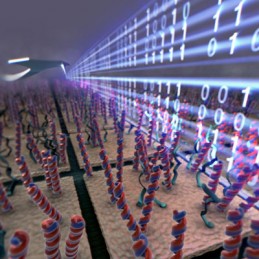Unique nanomechanical response of DNA allows high-speed direct digital detection
December 22, 2009 | Source: nanowerk

A new type of nanoscale sensor feels the stiffness of DNA molecules on a microarray to distinguish the ones that formed the double helix with digital precision. The new technology dramatically improves and simplifies microarray analysis. (Sahin Group, Rowland Institute at Harvard)
A new type of nanoscale sensor feels the stiffness of DNA molecules on a microarray to distinguish the ones that formed the double helix, with digital precision.
This technique is several orders of magnitude more sensitive than other approaches (such as fluorescent labels) and could allow for genetic tests for patients in the doctor’s office.
*By placing short stands of DNA with known sequences on a surface and watching if molecules from a biological sample (tissue, blood, etc) bind to these immobilized DNAs, researchers can determine genetic composition of the sample and help identify mutations responsible for diseases or help guide the doctor to choose the best treatment strategy.